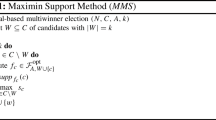Abstract.
The main flaw of the Condorcet method is that a Condorcet winner does not always exist (when there is a top cycle). Moreover, in some cases, all candidates are contained in one cycle and, therefore, a society or committee using the Condorcet method risks to face a severe indeterminacy. An indeterminacy can also happen when using other methods: for example the Borda method, plurality voting or any scoring method; but the origin of the indeterminacy is completely different. It happens when all candidates are tied. We study the probability that all candidates are tied when using a scoring method. We show that it is equivalent to some random walk problems. Some analytical and numerical results show that, under the assumptions underlying our study, the probability is very small and decreases when the number of voters or candidates increases.
Similar content being viewed by others
Author information
Authors and Affiliations
Additional information
Received: 18 December 1998/Accepted: 17 March 2000
Rights and permissions
About this article
Cite this article
Marchant, T. The probability of ties with scoring methods: Some results. Soc Choice Welfare 18, 709–735 (2001). https://doi.org/10.1007/s003550000078
Issue Date:
DOI: https://doi.org/10.1007/s003550000078




